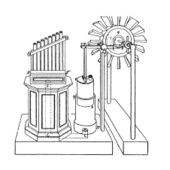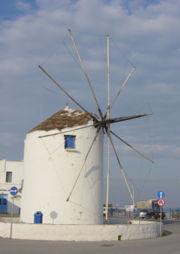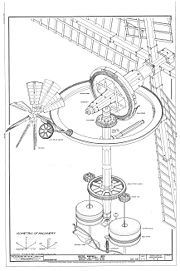Windmills
A windmill is a machine that is powered by the energy of the wind. It is designed to convert the energy of the wind into more useful forms using rotating blades or sails. The term also refers to the structure it is commonly built on. more...
In much of Europe, windmills served originally to grind grain, though later applications included pumping water and, more recently, generation of electricity.
History
A windmill operating an organ is described as early as the 1st century AD by Hero of Alexandria, marking probably the first instance of a wind powering machine in history. Vertical axle windmills were first used in eastern Persia (Sistan) by the 9th century AD as described by Muslim geographers. Horizontal axle windmills of the type generally used today were invented in Northwestern Europe in the 1180s.
Vertical axle windmills
The first windmills had long vertical shafts with rectangle shaped blades and appeared in Persia in the 9th century. The authenticity of an earlier anecdote of a windmill involving the second caliph Umar (634-644 AD) is questioned on the grounds of being a 10th century amendment. Made of six to twelve sails covered in reed matting or cloth material, these windmills were used to grind corn or draw up water, and quite different from the European versions. A similar type of vertical shaft windmill with rectangle blades, used for irrigation, can also be found in 13th century China (during the Jurchen Jin Dynasty in the north), introduced by the travels of Yelü Chucai to Turkestan in 1219.
Horizontal axle windmills
Fixed windmills, oriented to the prevailing wind were, for example, extensively used in the Cyclades islands of Greece. The economies of power and transport allowed the use of these 'offshore' mills for grinding grain transported from the mainland and flour returned. A 1/10th share of the flour was paid to the miller in return for his service. This type would mount triangular sails when in operation.
In North Western Europe, the horizontal-shaft or vertical windmill (so called due to the dimension of the movement of its blades) dates from the last quarter of the 12th century in the triangle of northern France, eastern England and Flanders. Joseph Needham states that the earliest known reference came in 1191 by a Dean Herbert of East Anglia, who supposedly competed with the mills of the abbey of Bury St Edmunds. These earliest mills were used to grind cereals. The evidence at present is that the earliest type was the post mill, so named because of the large upright post on which the mill's main structure (the "body" or "buck") is balanced. By mounting the body this way, the mill is able to rotate to face the (variable) wind direction; an essential requirement for windmills to operate economically in North-Western Europe, where wind directions are various. By the end of the thirteenth century the masonry tower mill, on which only the timber cap rotated rather than the whole body of the mill, had been introduced. In the Netherlands these stone towerlike mills are called "round or eight-sided stone stage mills, ground-sailers (windmills with long blades/sails reaching almost down to the ground), mound mills, etc." (Dutch: ronde/achtkante stenen stelling molens, grond-zeilers, beltmolens, etc.). Dutch tower mills ("torenmolens") are always cylindrical (such as atop castle or city wall towers). Due to the fact that only the cap of the tower mill needed to be turned the main structure could be made much taller, allowing the blades to be made longer, which enabled them to provide useful work even in low winds. Windmills were often built atop castle towers or city walls, and were a unique part of a number of fortifications in New France, such as at Fort Senneville.
Read more at Wikipedia.org






